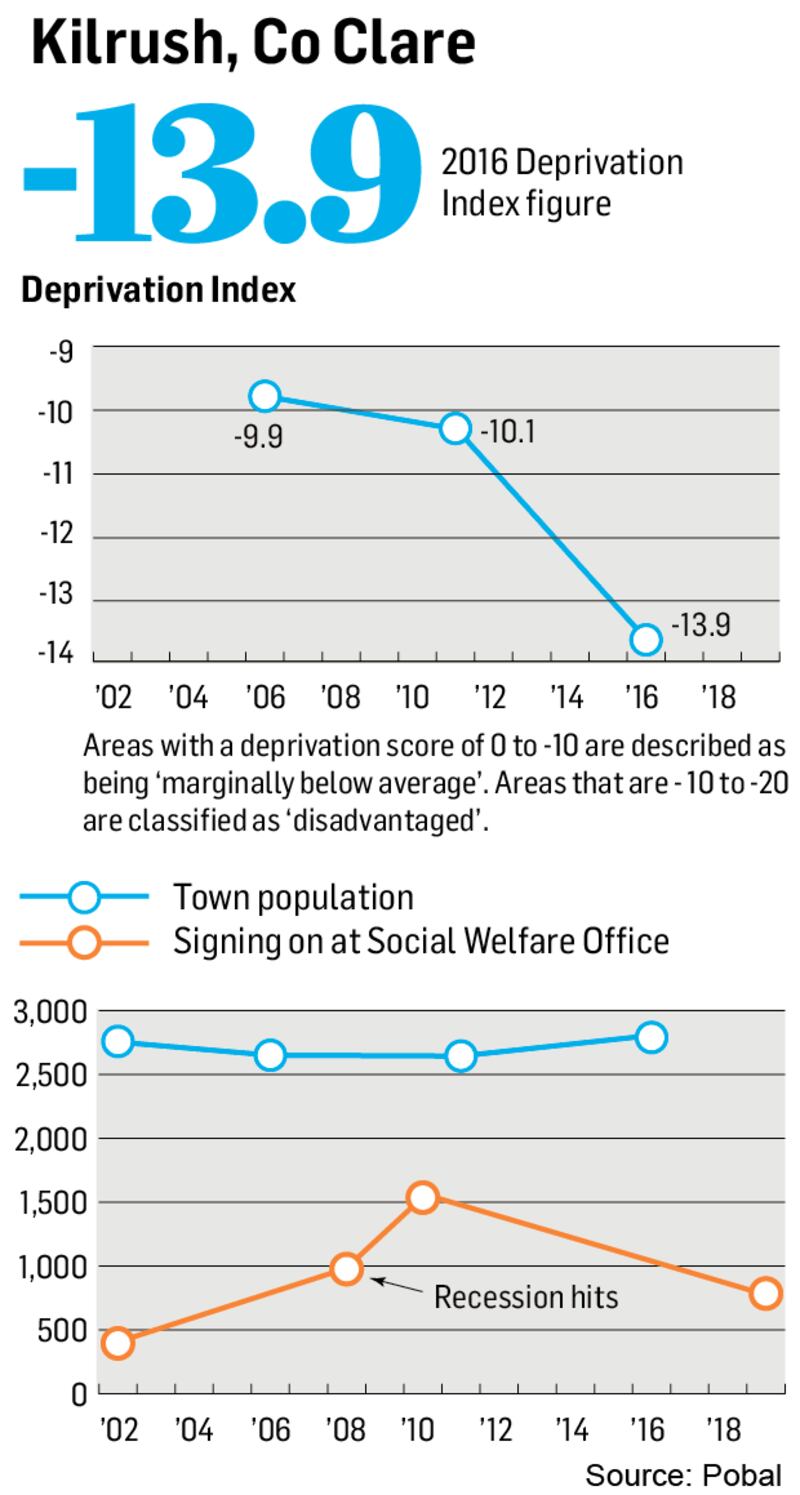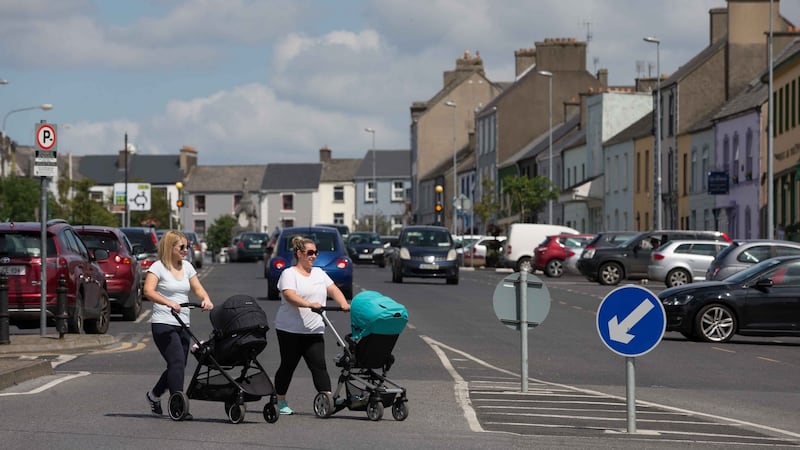In a series of articles, The Irish Times explores five challenges facing rural Ireland – diversity and migration; poverty; rapid growth; post-recession recovery; and depopulation – and ways to overcome them.
I'm standing with Irene Hamilton in the ruins of what used to be her father's house, on Scattery Island in Kilrush, Co Clare. As school tours explore the round tower in the distance, she is describing her vision for how this largely underappreciated island can become one of the major tourist attractions along the Wild Atlantic Way, and help turn Kilrush's fortunes around.
It involves restoring the whole street back to how it would have been before the last inhabitants left in the 1970s, and it is fair to say that it requires a leap of imagination: all that remains of the “street” are a few ruined cottages, stripped of everything except for doorways, fireplaces and an old postbox.
But Kilrush’s hopes of becoming a major stopping point on the Wild Atlantic Way hinge, at least in part, on Hamilton’s ability to realise this vision. She started Scattery Island Tours in 2017, with a 12-passenger boat, after she spotted a newspaper ad looking for a ferry operator to run a service from Kilrush to Scattery. At the time, she was studying for an MBA and looking for a change in direction from her job as a regional managing director for a newspaper group.
We've lost a whole generation who would now be between 27 and 37 years old
“I thought I’ll do this; I’ll go and get a boat, and put a ticket office in, and see how it goes.”
After a successful first year, she launched a 70-passenger ferry in 2018, funded by private investors through a BIS scheme.
Back at the marina, built in 1991, amid controversy over cost overruns and a so-far unrealised promise to turn Kilrush into Kinsale, there are other signs of the long-awaited reinvention of the west Clare market town. A brand new aquapark and a set of glamping pods float on the water.
Set in the old post office in the middle of the main square is Kilrush’s other bright new hope: the Kilrush digital hub, which offers co-working spaces and one-gigabyte broadband. “I don’t think the importance of that broadband can be overstated for small towns,” says Padraig Neylon, who relocated to Kilrush three years ago, and whose work as a building surveyor requires broadband.

It is here in the Digital Hub that the Town Team, set up by the Clare Market Towns project, meets once a month to plan a strategy for the growth and rebranding of the town.
The town’s population of 2,700 has remained largely unchanged since 2002. But the headline figure masks a gap in people aged between 19 and 34, who make up just 16 per cent of the population. “We’ve lost a whole generation who would now be between 27 and 37 years old,” says Jack Kelly, who runs Kelly’s Meat Shop and wholesale business on Henry Street.
Unbelievable hit
“After the crash in 2008 and 2009, no more than any other town in the country, Kilrush took an unbelievable hit. A whole age group from 20 to 30 literally upped sticks and were gone. I see it here in the shop, there’s an absolute hole in my customer profile. That gap is going to follow me right through until I retire.”

As a result, too, “the peripheral schools around the area are struggling to make up the numbers. Most of the GAA teams are amalgamated with next door parishes, which never happened in west Clare. The rugby team hasn’t fielded an adult team in three seasons.”
In 2016, the unemployment rate was 30 per cent, well above the state average. The Pobal deprivation index rates the town as “disadvantaged”. The commercial vacancy rate is nearly 27 per cent, the second highest in Ireland.
It’s not so much that the town had a tough recession; it’s more that the boom never arrived at all. Pat Clancy is looking at some of the empty units set at the ground floor of the handsome Georgian buildings across the street from his shop, Rico’s Menswear, which has been here for 150 years.

“A lot of them are empty 20 years. It’s not today or yesterday that they became empty. It’s not like there’s a sudden crisis of business failing.”
The rot set in more slowly. When individual shops closed down, there were not any to replace them.
The recession was “deadly”, says Clancy. “I nearly went. Because it was a family business, I just wanted to keep it going.” He worries that a small thing could turn it again. But “I’ve had a few good sales this morning. It’s not dead yet.”
One of Kilrush’s biggest issues has been a lack of political representation at national level, he feels. “Yer man passed by here one day, Jackie Healy-Rae, and he says, ‘You’ve a fine town here, boys’. And I said back to him, ‘it would be a lot better if it was below in Kerry. It would be flying it’.”
Across Frances Street, Sean Dunleavy is behind the counter in Burke’s Menswear, another of Kilrush’s long-established family businesses. It has been in operation since 1928. He lists the town’s assets: Scattery Island; the marina; the Vandeleur gardens; the Shannon; the proximity to Loop Head, the cliffs at Kilkee and the golf club at Doonbeg.
Family business
But the business environment is tough. Dunleavy’s own family business, a grocery shop on Moore Street, was one of the casualties of competition from out-of-town retailers. “The big boys came in, and we closed up. That was the end of it.”
Now, he says, he won’t buy anything in a supermarket that he can buy locally instead. “When you come into a town, and you see the shops all closed all along the main street – it’s the locals made that decision. Nobody else made that decision. So it’s about what kind of Ireland do you want?”
Charlie Glynn, the 30-year-old chair of the Town Team, an initiative supported by Clare Local Development Company, has been giving a lot of thought to the kind of Kilrush that he wants. Glynn grew up on Frances Street and left college in 2010, when the country was on the brink of the recession. He is part of that generation that mostly vanished from Kilrush, but unlike many others, he has been able to come back.
We could have been where Westport is now, if we started sooner
In 2012 he set up a business manufacturing and export synthetic diamond products with other family members, and has thrown himself into the task of making Kilrush somewhere that can offer a future to people of his generation. “Tourism can’t be the be-all and the end-all. If you make Kilrush a better place for its inhabitants, then the people will come. It’s that simple.”
For surveyor and Town Team volunteer Padraig Neylon, the attraction in moving here was the lifestyle Kilrush could offer – his wife, Julie Moore-Neylon set up an optician’s on Frances Street, and they bought a house on the other side of the street.
In the beginning, he says, “there was a little bit of shock from people in Kilrush that we were moving back. People would say ‘Are you sure you want to leave Galway, where everything’s happening?’”
After all, for years most of the movement of people their age had been in the other direction. Can that trend, and the decline of Kilrush, be reversed? Glynn believes that with a proper strategy, better branding and people to drive it forward, it can.
“We could have been where Westport is now, if we started sooner. If you go back 15 years ago we had the hotel; the place was bustling. But Kilrush has turned a corner.”
Additional reporting: Nora-Ide McAuliffe
Analysis
Fintan O’Toole: ‘Rural Ireland’ has been romanticised up to its neck
David McWilliams: We need to move public servants out of Dublin
Challenges facing rural Ireland’s needs centralised decision-making
Two-thirds of towns with 10,000 people are in Leinster
Immigration is as much a rural phenomenon as an urban one
The stark problem for Irish towns is simple: they need people











